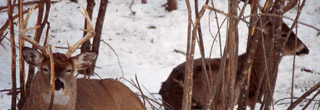Not many days into a typical whitetail hunting season, most hunters begin wondering, where all the deer went. The answer depends on how you’ve been hunting. If you’ve been making drives or still-hunting (wandering aimlessly), most deer are then almost certain to be located where hunters aren’t making drives or still-hunting: in posted lands, for example, refuges or swamps and bogs, some of which may be as far away as 6–30 miles. If you’ve been stand hunting at one stand site where most hunters are stand hunting (during an archery season, for example), chances are most deer there are living quite normal lives out of sight 100 yards or more away.
Imagine hunting in an area where deer are merely living out of sight during an entire hunting season – like where my three sons, two grandsons, me and a number of weekend-only others hunt during a firearm season. We are stand hunters, of course, but not typical stand hunters. We rarely use a stand site longer than one-half to one day. The reason is, we hunt mature bucks only. Today, such deer are so skilled at finding, identifying and avoiding stand hunters in trees or on the ground that it is generally a waste of time to remain at one stand site longer than that.
Stand sites we use during the first 2–3 days of a hunting season are selected and prepared (if necessary) 2–3 weeks before the opener. During the rest of the hunting season, most are spur-of-the-moment, never-used-before selections near very fresh-deer signs. How, you might wonder, can so many hunters find and use so many stand sites, during the course of a hunting season without spooking and chasing all deer out of your hunting area?
The answer lies in another question: aside from “jumping” deer and alarming them enough to make them raise their tails and bound away, what makes whitetails abandon their ranges during a hunting season? The answer is, “overwhelming, much-feared trail and airborne scents emitted by hunters. Wherever a hunter travels on foot, a carpet of intense human odors that lasts four or more days is laid down and the hunter’s airborne odors sweep across the landscape throughout a triangular-shaped area 200 yards wide and 200 yards downwind. Airborne odors soon disappear after a hunter passes but continue unabated wherever a hunter halts to stand hunt.
Recent research by law enforcement officers in Minnesota have proven nothing a deer hunter can buy that is claimed to eliminate human odors can keep a K-9 dog from finding a human as quickly as a human not using these products. This means, of course, equally or more sensitive noses of whitetails cannot be fooled either (as I have been insisting since the 1970s). Sorry guys, this means today’s whitetail hunters must do something more than use certain soaps or soda, wear certain clothing or boots or spray themselves with certain potions to avoid being smelled and thus avoided by whitetails.

